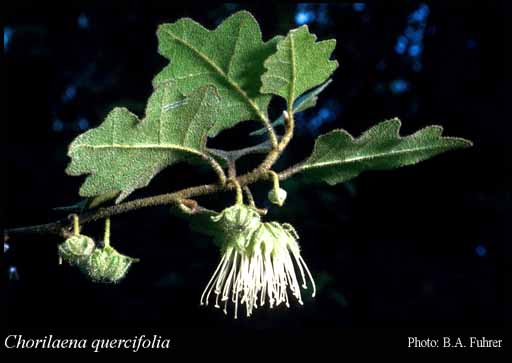- Reference
- Endl., Fenzl, Benth. & Schott, Enum.Pl. 17 (1837)
- Conservation Code
- Not threatened
- Naturalised Status
- Native to Western Australia
- Name Status
- Current
Shrub or tree, 0.5-5 m high. Fl. yellow-cream-white-green, Apr to May or Jul or Sep to Dec or Jan. Sandy & loamy soils. Rocky coast & hillsides, granite & limestone rocks.

Scientific Description
Shrub, spines absent; branchlets smooth, without distinct raised glands, +/- cylindrical in cross-section, covered in hairs or scales, the hairs stellate (star-shaped). Leaves alternate, simple, 20(-65) mm long, 15-30 mm wide, flat, smooth, without distinct raised glands, covered in hairs or scales, with stellate (star shaped) hairs; stipular excrescences absent. Flowers in a distinct head surrounded by bracts, the outer bracts 8-9 mm long; pedicels 4-6 mm long; calyx present, 5-7 mm long, smooth, without distinct raised glands, covered in hairs or scales, the hairs stellate (star-shaped); corolla yellow, white or cream or green, petals five, 8-9 mm long, valvate (not overlapping), free, hairy on the surfaces; stamens twice as many as petals, 16-17 mm long, smooth, ciliate (with a marginal fringe of hairs); anthers 1.4-1.5 mm long, without an appendage; style 16-18 mm long, glabrous. Flowers in January, April, May, July, September, October, November and December. Occurs in the South-West Botanical Province, in the Jarrah Forest, Warren and Esperance IBRA region(s).
Distribution
- IBRA Regions
- Esperance Plains, Jarrah Forest, Warren.
- IBRA Subregions
- Fitzgerald, Southern Jarrah Forest, Warren.
- IMCRA Regions
- Leeuwin-Naturaliste, WA South Coast.
- Local Government Areas (LGAs)
- Albany, Augusta Margaret River, Busselton, Denmark, Manjimup, Nannup, Plantagenet.